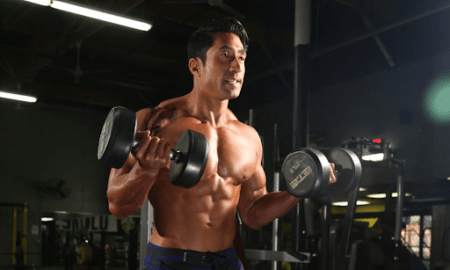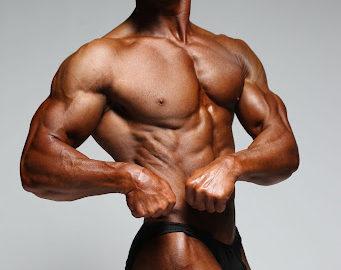Q: What do you think is the most common training reason that people can’t build big arms?
A: One thing that’s common to men with little arms is that they don’t do a lot of direct work for the brachialis. The brachialis is primarily a fast-twitch muscle, and virtually everyone who has big arms devotes a significant amount of time to working it. That was particularly true before anabolic steroid use became rampant and trainees actually had to slave away in the gym. I’m talking about the Reg Park–Clancy Ross era.
That’s why the reverse curl is the most underrated arm exercise. If you haven’t made any progress in months or years, simply start each workout with reverse curls. In fact, any arm flexor movement done with the palms facing the floor or in a semisupinated position will work the brachialis. In other words, you have to reverse to move forward in arm size.
Q: How would you rate leg presses in comparison to squats?
A: Squats are far more effective in increasing overall strength, particularly strength that’s transferable to the sporting field. One of the problems with the leg press is that it keeps the lower back out of the equation, thus making a weak link in the chain.
There’s some evidence, however, that leg presses might result in more hypertrophy of the quadriceps. One study showed that for the same number of reps, the leg press generated a greater amount of growth hormone release than squats. The leg press is the exercise of choice for speed skaters, and I’ve worked with speed skaters whose legs made Tom Platz’s look like Woody Allen’s.
I’m not recommending leg presses instead of squats. I merely present it as an interesting discussion point. If hypertrophy is your sole concern, I suggest alternating the two exercises to get the greatest muscle mass increases.
Q: What do you think is the limiting training factor in hypertrophy?
A: Most bodybuilders don’t grow. Why? Because they’re too weak. From the late ’50s to the early ’70s bodybuilders espoused strength training because training facilities were limited and training dogma was influenced by the Olympic lifters and powerlifters who shared training quarters with them.
Now, let’s say a guy can do 250 for eight in the bench press and his pecs are at their limit. He can then go on a strength cycle. If he does 250 for eight, his max should be about 320. If he goes on a strength cycle and gets his bench up to 360, he can do 280 when he does his sets of eight. And if he can use 280, his pecs are going to grow because he can use enough weight, long enough, to stimulate growth.
Q: When I train, I seem to get fatigued mentally after only 20 minutes. The muscles seem like they want to keep going, but I just can’t keep it together. Any suggestions?
A: What you’re experiencing is probably central nervous fatigue, but there could be other factors, such as hypoglycemia caused by eating too many high-glycemic carbs before the workout. Make sure that the glycemic index of your preworkout meal doesn’t exceed a value of 50, a very safe number. That should help your concentration during your workouts.
Many of my clients who switch their preworkout meal of oatmeal with a banana and raisins to steak and cashews report an immediate escape from the midworkout blahs.
Assuming that your nutrition is correct, you’re probably experiencing some problems with your neurotransmitters. One of the causes of fatigue during exercise is the enhanced conversion of the amino acid tryptophan into 5-HTP, which makes you drowsy and creates fatigue. As you may be aware, 5-HTP is sold as a supplement to enhance sleep, particularly for the fibromyalgia market.
There is, however, a solution, which comes in the form of a readily available supplement. My suggestion is based on recent studies done in Sweden and Japan on the effects of branched-chain amino acids on delaying fatigue. The research shows a very simple way to offset the conversion: Take five grams of branched-chain amino acids at the beginning of the workout. The BCAAs will compete with the tryptophan, so the fatigue symptoms won’t show up.
Q: What do you think of the standard breakfast of pro bodybuilders that you see in the popular muscle mags? You know, egg whites, banana and oatmeal with raisins.
A: It’s a terrible choice. The glycemic load of that combination is too high. Bananas and raisins have a high-glycemic index, and so does oatmeal, so insulin levels climb after that breakfast. No wonder that after that type of breakfast the newbie needs ephedra or caffeine. Your blood sugar is crashing because of the insulin rush, so your body tells you to go to Starbucks to pour down some java; then your cortisol increases so you can have energy to work out.
Egg whites are one of my pet peeves. Eggs should be eaten whole; forget that cholesterol propaganda. It has no scientific basis. Egg whites are digested too fast. Whole eggs are better at supporting healthy glucose levels. When we run food-sensitivity tests at the Poliquin Strength Institute, it’s the most common food allergen, not because of genetics but because they are inhaled, not chewed, by bodybuilders.
After you eat a high-glycemic breakfast, your workout will diminish, and you won’t be able to put in the intensity necessary to make gains.
Q: How valuable do you think Reishi is to the strength athlete?
A: The world’s first plant monograph was done on a Reishi mushroom. Referred to as “the mushroom of immortality,” it’s known in Chinese medicine as “the plant for the professor who lived too much inside his head.” It’s great for athletes who tend to worry too much or have obsessive-compulsive disorders.
Reishi’s active ingredients include sterols, coumarin, mannitol, polysaccharides and triterpenoids called ganoderic acids, which may lower blood pressure as well as low-density lipoprotein, the harmful type of cholesterol. It’s a strong anti-inflammatory and antioxidant that lowers cortisol. That gives it anabolic properties as it shifts the DHEA-to-cortisol ratio favorably and encourages protein synthesis instead of catabolism.
Q: Based on your writings you’re obviously a strong believer in fish oil for changing body composition. Is there anything you would add to increase its effectiveness? I’m looking for a synergistic effect.
A: The omega-3s from fish oil turn on the lipolytic, or fat-burning, genes and turn off the lipogenic, or fat-storing, ones. The amino acid carnitine is often the limiting factor in the chemical reactions involved in the fat-burning processes.
Carnitine plays a critical role in converting fatty acids into fuel, so it can help you lose bodyfat. Muscles, liver, kidney and heart tissues heavily depend on carnitine to convert fat into energy. If carnitine is deficient, fatty acids will accumulate in the body. Carnitine helps transport fatty acids into mitochondria, where they’re used for energy production. A rule of thumb in physiology is that where fat goes, carnitine will follow.
Carnitine deficiency is more common in vegetarian women. Women usually have lower protein intake than men, and vegetarian diets have extremely poor carnitine content.
Carnitine’s effect on burning bodyfat is optimized when DHEA levels are their best. That’s why carnitine’s effects on fat loss aren’t always consistent. DHEA is known to upregulate carnitine-related enzymes that promote the use of fatty acids as fuel—which is another reason to have your hormone profile checked on a regular basis.
Carnitine mitigates the cholesterol and triglycerides normally associated with high-fat diets. It reduces serum triglycerides and very low-density lipoprotein cholesterol. Carnitine increases favorable high-density-lipoprotein cholesterol, high-density-lipoprotein 2 cholesterol and albumin.
To purchase high-quality carnitine, call us at (401) 398-7845.




















You must be logged in to post a comment Login